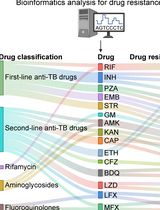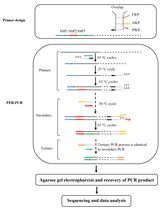- EN - English
- CN - 中文
CRISPR/Cas9-mediated ssDNA Recombineering in Corynebacterium glutamicum
谷氨酸棒状杆菌中CRISPR/Cas9介导的ssDNA重组工程技术
(*contributed equally to this work) 发布: 2018年10月05日第8卷第19期 DOI: 10.21769/BioProtoc.3038 浏览次数: 7518
评审: David CisnerosJuan Facundo Rodriguez AyalaPeter E Burby

相关实验方案

I-PREFR:基于反向PCR的无酶单向策略,利用自杀载体在细菌中快速实现无标记染色体基因缺失与重建
Rekha Rana [...] Prabhu B. Patil
2025年05月20日 1345 阅读
Abstract
Corynebacterium glutamicum is a versatile workhorse for industrial bioproduction of many kinds of chemicals and fuels, notably amino acids. Development of advanced genetic engineering tools is urgently demanded for systems metabolic engineering of C. glutamicum. Recently unveiled clustered regularly interspaced short palindromic repeats (CRISPR) and their CRISPR-associated proteins (Cas) are now revolutionizing genome editing. The CRISPR/Cas9 system from Streptococcus pyogenes that utilizes NGG as protospacer adjacent motif (PAM) and has good targeting specificity can be developed into a powerful tool for efficient and precise genome editing of C. glutamicum. In this protocol, we described the general procedure for CRISPR/Cas9-mediated ssDNA recombineering in C. glutamicum. Small modifications can be introduced into the C. glutamicum chromosome with a high editing efficiency up to 90%.
Keywords: CRISPR/Cas9 (CRISPR/Cas9)Background
The Gram-positive soil bacterium Corynebacterium glutamicum is a versatile workhorse for industrial bioproduction of amino acids, biofuels, and polymer building blocks (Becker et al., 2016). At the early stage of engineering of C. glutamicum, random mutagenesis combined with positive selection by phenotypic resistance to amino acid analogs was the most commonly used strategy (Vertes et al., 2005). Genetic manipulations in C. glutamicum were initiated in 1984 and became a key enabling strategy for strain improvement (Ozaki et al., 1984). A routinely used method for gene disruption and insertion in C. glutamicum is based on integration of a suicide vector into its chromosome, followed by a second recombination event to remove the plasmid backbone and a counter-selection step using a conditionally lethal marker. Nevertheless, due to the frequent spontaneous inactivation of the counter-selectable marker sacB, up to 45% of colonies obtained in the screening process were false-positive, making this multi-step procedure time-consuming and inefficient (Schafer et al., 1994). To engineer C. glutamicum more efficiently, simple but versatile genome editing tools are still in urgent demand.
Recently, clustered regularly interspaced short palindromic repeats (CRISPR) and their CRISPR-associated proteins (Cas) have been explored as a leading-edge tool for bacterial genome editing (Choi et al., 2016). The CRISPR/Cas9 system accepts NGG protospacer adjacent motif (PAM) and has good targeting specificity (Jiang et al., 2013). Therefore, the CRISPR/Cas9 system is expected to possess abundant editing targets in GC-rich C. glutamicum. We successfully developed a CRISPR/Cas9 toolbox for efficient and comprehensive engineering of C. glutamicum strains (Liu et al., 2017; Wang et al., 2018). By using the tailor-made CRISPR/Cas9 system, efficient deletion and insertion of large DNA fragments using plasmid-borne editing templates were achieved. By combining CRISPR/Cas9 and ssDNA recombineering, small modifications were introduced into the genome with efficiencies up to 90% (Liu et al., 2017). Besides, targeted based editing without donor DNA was also realized using Cas9 and cytidine deaminase fusions (Wang et al., 2018). The toolbox developed is simple and versatile, which is expected to overcome the major limitations of existing genome editing tools of C. glutamicum and advance the genetic manipulation of this industrial workhorse. Herein, we described the detailed protocol for CRISPR/Cas9-mediated ssDNA recombineering in C. glutamicum.
Materials and Reagents
- 0.2 ml PCR tubes (Biosharp, catalog number: BS-02-P )
- 1.5 ml Eppendorf tubes (Biosharp, catalog number: BS-15-M )
- Pipette tips (Biosharp, catalog numbers: BS-10-T , BS-200-T , BS-1000-T )
- Petri dishes (NEST Biotechnology, catalog numbers: 752001 )
- Competent Escherichia coli DH5α cells (CWBIO, catalog number: CW0808 )
- pgRNA5 plasmid (Liu et al., 2017)
- pCas9 plasmid (Liu et al., 2017)
- Agarose (Biowest, catalog number: 111860 )
- GoldView I Nuclear Staining Dyes (10,000x) (Solarbio, catalog number: G8140 )
- AxyPrepTM DNA Gel Extraction Kit (Corning, Axygen®, catalog number: AP-GX-250 )
- Tryptone (Oxoid, catalog number: LP0042 )
- Yeast extract (Oxoid, catalog number: LP0021 )
- Kanamycin (Solarbio, catalog number: K8020 )
- Chloramphenicol (Fisher Scientific, catalog number: BP904-100 )
- Q5® High-Fidelity DNA polymerase (New England Biolabs, catalog number: M0491L )
- AxyPrepTM Plasmid Miniprep Kit (Corning, Axygen®, catalog number: AP-MN-P-250 )
- Vazyme ClonExpress® II One Step Cloning Kit (Vazyme Biotech, catalog number: C112-01/02 )
- 2x EasyTaq PCR SuperMix (+dye) (Beijing TransGen Biotech, catalog number: AS111-11 )
- Tris base (Solarbio, catalog number: T8060 )
- Glacial acetic acid (Sinopharm Chemical Reagent, catalog number: 10000218 )
- EDTA (Solarbio, catalog number: E8030 )
- NaCl (Sinopharm Chemical Reagent, catalog number: 10019328 )
- Agar (Solarbio, catalog number: A8190 )
- (NH4)2SO4 (Solarbio, catalog number: A8821 )
- K2HPO4 (Solarbio, catalog number: D9880 )
- NaH2PO4 (Solarbio, catalog number: S5830 )
- MgSO4•7H2O (Sinopharm Chemical Reagent, catalog number: 10013018 )
- Brain Heart Infusion (BHI) (BD, catalog number: 237500 )
- Tween 80 (Solarbio, catalog number: T8360 )
- DL-threonine (DL-Thr) (Tokyo Chemical Industry, catalog number: T3105 )
- Glycine (Gly) (Solarbio, catalog number: G8200 )
- Glucose (Beijing Dingguo Changsheng Biotechnology, catalog number: DS063 )
- Trisodium citrate (Solarbio, catalog number: S8220 )
- Sorbitol (Solarbio, catalog number: S8090 )
- Isonicotinic acid hydrazide (INH) (Sigma-Aldrich, catalog number: I3377 )
- IPTG (Solarbio, catalog number: I8070 )
- Sodium propionate (Sigma-Aldrich, catalog number: P1880 )
- Oligo for ssDNA recombineering:
AGGTAAGGCGCACACGAGCGACCTTACGAAGAGCAGAGTTAGGCTTGCGAGGGGTGGTGGTGTACACACGGGTGCATACGCCACGACGCT (synthesized and page-purified in Genewiz, Suzhou, China) - Primers for gRNA plasmid construction (synthesized and page-purified in Genewiz, Suzhou, China):
gRNA-1: AGAGCAGAGTTAGGCTTCTTGTTTTAGAGCTAGAAATAGCAAG
gRNA-2: TGCTCTTTCATTGATGGCTGG
gRNA-3: CAGCCATCAATGAAAGAGCAAC
gRNA-4: AAGAAGCCTAACTCTGCTCTTGAATTACACTGTACCTGTTGCGTC - 50x TAE electrophoresis buffer (see Recipes)
- 1x TAE electrophoresis buffer (see Recipes)
- LB medium (see Recipes)
- LB solid medium (see Recipes)
- BHI medium (see Recipes)
- NCM medium (see Recipes)
- BHIS medium (see Recipes)
- LBHIS solid medium (see Recipes)
- 25 mg/ml kanamycin stock (see Recipes)
- 5 mg/ml chloramphenicol stock (see Recipes)
- 0.1 M IPTG stock (see Recipes)
- 500 g/L sodium propionate stock (see Recipes)
Equipment
- Pipettes (Eppendorf, catalog number: 022575442 )
- Thermal cycler (Thermo Fisher Scientific, Thermo ScientificTM, model: ArktikTM Thermal Cycler )
- Water bath (Beijing Ever Bright Medical Treatment Instrument, model: DZKW-S-4 )
- NanoDrop (Thermo Fisher Scientific, Thermo ScientificTM, model: NanoDropTM 2000 )
- Milli-Q H2O dispenser (Thermo Fisher Scientific, Thermo ScientificTM, model: BarnsteadTM GenPureTM Pro , catalog number: 50131950)
- Centrifuge (Eppendorf, model: 5084 R , catalog number: 5805000696)
- Electroporation cuvette (Bio-Rad Laboratories, catalog number: 1652082 )
- -20 °C freezer (Panasonic, catalog number: MDF-U548D-C )
- pH meter (Fisher Scientific, model: Fisher ScientificTM accumetTM AB150, catalog number: 13-636-AB150 )
- DNA electrophoresis apparatus (Beijing LIUYI Biotechnology, catalog numbers: DYY-6C and DYCP-32B )
- Electroporator (Eppendorf, model: Electroporator 2510 )
- Autoclave (SANYO, catalog number: MLS-3750 )
Software
- Primer Premier 5 (Premier Biosoft International)
- sgRNAcas9 (Xie et al., 2014)
Procedure
文章信息
版权信息
© 2018 The Authors; exclusive licensee Bio-protocol LLC.
如何引用
Liu, J., Wang, Y., Zheng, P. and Sun, J. (2018). CRISPR/Cas9-mediated ssDNA Recombineering in Corynebacterium glutamicum. Bio-protocol 8(19): e3038. DOI: 10.21769/BioProtoc.3038.
分类
微生物学 > 微生物遗传学 > DNA
分子生物学 > DNA > 染色体工程
您对这篇实验方法有问题吗?
在此处发布您的问题,我们将邀请本文作者来回答。同时,我们会将您的问题发布到Bio-protocol Exchange,以便寻求社区成员的帮助。
提问指南
+ 问题描述
写下详细的问题描述,包括所有有助于他人回答您问题的信息(例如实验过程、条件和相关图像等)。
Share
Bluesky
X
Copy link













